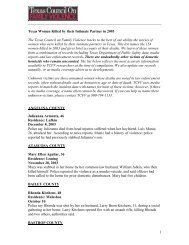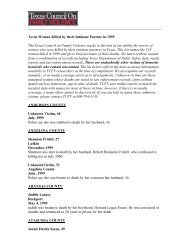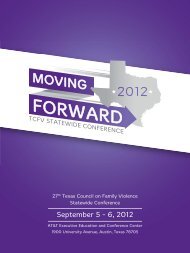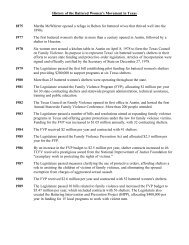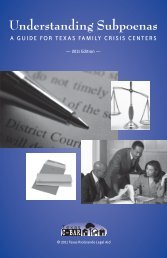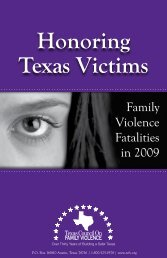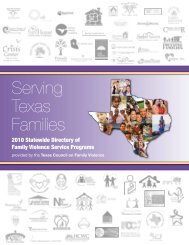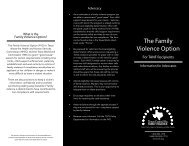the essential guide - Texas Council on Family Violence
the essential guide - Texas Council on Family Violence
the essential guide - Texas Council on Family Violence
You also want an ePaper? Increase the reach of your titles
YUMPU automatically turns print PDFs into web optimized ePapers that Google loves.
Leaving an Abusive Relati<strong>on</strong>shipThere are many reas<strong>on</strong>s whysome<strong>on</strong>e might stay in an abusiverelati<strong>on</strong>ship:Emoti<strong>on</strong>al c<strong>on</strong>necti<strong>on</strong>, loveand/or hope <str<strong>on</strong>g>the</str<strong>on</strong>g> violence willstop and <str<strong>on</strong>g>the</str<strong>on</strong>g> relati<strong>on</strong>ship will getbetter.C<strong>on</strong>cerns for children, familyand/or cultural expectati<strong>on</strong>s orshame.Financial dependence and/orlack of support or resourcesSafety c<strong>on</strong>cernsPlease note:Leaving an abusive relati<strong>on</strong>shipincreases <str<strong>on</strong>g>the</str<strong>on</strong>g> risk of being killed byan abusive partner both during <str<strong>on</strong>g>the</str<strong>on</strong>g>process of leaving and after havingleft <str<strong>on</strong>g>the</str<strong>on</strong>g> relati<strong>on</strong>ship.If we understand that family violenceis about maintaining power andc<strong>on</strong>trol, we can understand thisincreased risk: a partner who isgetting ready to leave or who has leftthreatens batterers’ c<strong>on</strong>trol andsome batterers may be willing to doanything, including kill, to regain it.It’s important to keep in mind ourrole in providing safety and workingwith survivors to strategize aboutsafety c<strong>on</strong>cerns.Safety planning must be an <strong>on</strong>goingelement of all advocacy services.Batterers will use abusive tactics to destabilize, destroy selfesteem,increase dependence, gain leverage, and reinforce threats(CPS, deportati<strong>on</strong>, jail, and hospitalizati<strong>on</strong>) to <str<strong>on</strong>g>the</str<strong>on</strong>g>ir partners.Batterers can use <str<strong>on</strong>g>the</str<strong>on</strong>g>se tactics to fur<str<strong>on</strong>g>the</str<strong>on</strong>g>r marginalize a partner andincrease <str<strong>on</strong>g>the</str<strong>on</strong>g> likelihood that <str<strong>on</strong>g>the</str<strong>on</strong>g>ir partner will face victim-blaming oro<str<strong>on</strong>g>the</str<strong>on</strong>g>r barriers when trying to leave or get help. Batterers may oftentry to justify abusive acti<strong>on</strong>s by claiming that <str<strong>on</strong>g>the</str<strong>on</strong>g>ir partner wasdrunk, crazy, or a bad mo<str<strong>on</strong>g>the</str<strong>on</strong>g>r, am<strong>on</strong>g o<str<strong>on</strong>g>the</str<strong>on</strong>g>r justificati<strong>on</strong>s.Fortunately, <str<strong>on</strong>g>the</str<strong>on</strong>g>re are steps we can take as advocates to counteract<str<strong>on</strong>g>the</str<strong>on</strong>g>se harms. We can strive to make our programs and services openand accessible to all. When survivors express guilt or shame foracti<strong>on</strong>s <str<strong>on</strong>g>the</str<strong>on</strong>g>y were forced to take, we can remind <str<strong>on</strong>g>the</str<strong>on</strong>g>m that batterersare solely resp<strong>on</strong>sible for <str<strong>on</strong>g>the</str<strong>on</strong>g>ir abusive acti<strong>on</strong>s and no <strong>on</strong>e deservesto be abused. We can point out to survivors <str<strong>on</strong>g>the</str<strong>on</strong>g> strength andresilience that it took to survive <str<strong>on</strong>g>the</str<strong>on</strong>g> abuse and acknowledge that<str<strong>on</strong>g>the</str<strong>on</strong>g>y did <str<strong>on</strong>g>the</str<strong>on</strong>g> best <str<strong>on</strong>g>the</str<strong>on</strong>g>y could with <str<strong>on</strong>g>the</str<strong>on</strong>g> resources available to <str<strong>on</strong>g>the</str<strong>on</strong>g>m atthat time. We can try to help survivors focus <strong>on</strong> <str<strong>on</strong>g>the</str<strong>on</strong>g> present,highlight <str<strong>on</strong>g>the</str<strong>on</strong>g>ir current opti<strong>on</strong>s, and provide support as <str<strong>on</strong>g>the</str<strong>on</strong>g>y makechoices to try and build a safer future. We can becomeknowledgeable about o<str<strong>on</strong>g>the</str<strong>on</strong>g>r support services in <str<strong>on</strong>g>the</str<strong>on</strong>g> community thatmay be of benefit to survivors.Warning Signs of a Batterer<strong>Family</strong> violence is never <str<strong>on</strong>g>the</str<strong>on</strong>g> fault of <str<strong>on</strong>g>the</str<strong>on</strong>g> victim. No <strong>on</strong>e knowinglyenters a relati<strong>on</strong>ship with an abusive pers<strong>on</strong>.The Nati<strong>on</strong>al Network to End Domestic <strong>Violence</strong> (NNEDV) hascompiled a list of subtle warning signs of a batterer (available atwww.nnedv.org). Sharing this informati<strong>on</strong> widely can help informo<str<strong>on</strong>g>the</str<strong>on</strong>g>rs and raise awareness about family violence.Warnings Signs of a Batterer: Moves too quickly into a relati<strong>on</strong>ship. Portrays a very charming demeanor or may seem too goodto be true. Insists partner stop participating in leisure activities orspending time with family and friends. Dem<strong>on</strong>strates extremely jealous or c<strong>on</strong>trolling behavior. Blames o<str<strong>on</strong>g>the</str<strong>on</strong>g>rs for everything that goes wr<strong>on</strong>g and nevertakes resp<strong>on</strong>sibility for any acti<strong>on</strong>s. Criticizes partner’s appearance and puts down partner.THE ESSENTIAL GUIDE: AN INTRODUCTION TO ADVOCATING FOR SURVIVORS OF FAMILY VIOLENCE12 | P a g e



